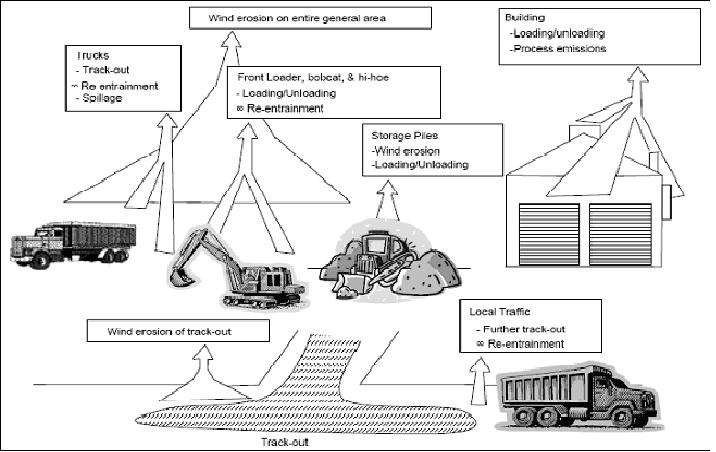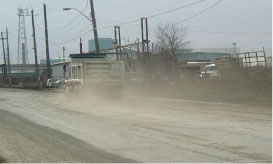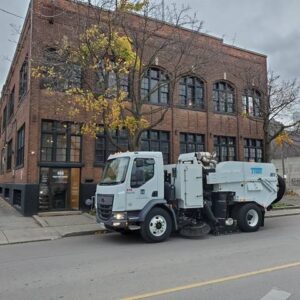Air Quality & Fugitive Dusts

Dusts and particulate matter, including road dusts, are a significant source of airborne pollution in Hamilton. Residents can learn about current levels of particulate matter in the City from the Hamilton Air Monitoring Network (HAMN) website, which includes real-time data from a number of air quality monitors throughout the City.
Studies conducted in cities around the world have demonstrated clearly and consistently that exposure to PM10 and PM2.5 can increase the risk of acute health impacts, such as premature deaths and hospital admissions, and chronic health impacts, such as respiratory problems, heart disease and lung cancer. More information is available on our Particulate Matter page.
What are Dusts and Particulate Matter?
Airborne dusts can consist of particulate matter of a variety of sizes and are created by a number of different source types.
Fugitive dusts arise from non-point sources, and include road dusts, agricultural dusts, dusts that arise from materials handling, construction operations, outdoor storage piles, etc. These are dusts that are not airborne to begin with, but are sent into the air primarily by wind or vehicle traffic. The compositions of fugitive dusts and road dusts vary depending upon the materials used or stored, adjacent land uses, local emission sources and traffic loads. For instance, dusts created by building demolition will be composed of whatever the building was constructed of, whereas agricultural dusts will include soil, as well as any fertilizers or pesticides that may have been applied.
Road dusts consist of particulate matter from vehicle exhausts, tire wear, pavement wear, brake wear, and can result from track-out (trucks dragging mud or dust off site and then depositing it to the air) from construction sites and industrial sites (particularly from unpaved roads), blow-off from construction sites, and the deposition of materials from the air, including industrial particulates and vehicle emissions. Road dusts can contain elevated levels of toxic substances such as chromium, manganese and polycyclic aromatic hydrocarbons (PAHs).

Dust Management and Control
There are many simple and cost-effective measures for dust control, including tarps, watering surfaces, wind fencing, vehicle cleaning stations, properly equipped street sweepers, and worker safety equipment such as dust masks where appropriate.
Dust and particulate matter on work sites is the responsibility of the Ministry of Labour. Provincially regulated employers in Ontario are required to ensure that exposure to dust and particulate levels are within the occupational exposure limits (OEL). Ministry of Labour inspectors and hygienists enforce OEL compliance by conducting inspections of workplaces. Click here for information on MOL regulations pertaining the control of dust and particulate matter.
Dust and particulate matter that migrates off of work sites is the responsibility of the Ministry of Environment and Climate Change. Section 49 of Ontario Regulation 419/05 states that no contaminant shall be carried beyond the limits of the property on which your construction or demolition is taking place unless every step necessary to control the emission of the contaminant has been implemented. The easiest way to control these emissions is to prepare a contaminant control plan ahead of any construction or demolition activities. Click here for Regulation 419/05, and here for more information on contaminant control plans.
The public health impacts of dust and particulate matter are the responsibility of the City of Hamilton’s Public Health Services. Research on the health effects of dust and particulate matter is made available on this website. In-depth guidance on managing dust and particulate matter emissions for construction and demolition projects is provided in our Contractor and Homeowner Dust Handbooks, available here.
Street Sweeping in Hamilton
The City of Hamilton uses TYMCO DST-6 Street Sweepers. These sweepers exceed PM10 requirements.

Photo of TYMCO DST-6 Street Sweeper courtesy of Dave Bertrant
The City of Hamilton’s Roads District North (Wards 1,2,3 and 4) runs multiple sweeping programs from April to November.
Each Spring, the City of Hamilton cones off over 350 locations to perform its biannual street-sweeping “posting” program.
Each day roughly 20 locations have no-parking from 8am to 12pm (4 hours). This allows city staff access to clean debris from curbs/catch basins that are not accessible for cleaning the rest of the year due to parking regulations.
Additionally, there is an alternate side parking Sweeping program which sweeps one side of the residential streets from 1st to 16th of each month as parking is restricted on that side and the other side is swept during the 2nd half of the month.
The City also does test Area Sweeping at various locations around the City of Hamilton with restricted parking for 4 hours once a month on various days.
If you would like to report dust or mud buildup on a road, please visit the City of Hamilton’s Road and Sidewalk Maintenance webpage here.
Did you know?
- In addition to city streets, the Keddy Access Trail is swept on the third Thursday each month.
- In 2022, 7083 tonnes of debris was swept of off Hamilton roads.
The City of Hamilton’s Roads North team sweeps on average 120km of roadway each day during the street sweeping season. Annually, that is the same distance as almost 5 round trips from Hamilton to Orlando, Florida!

